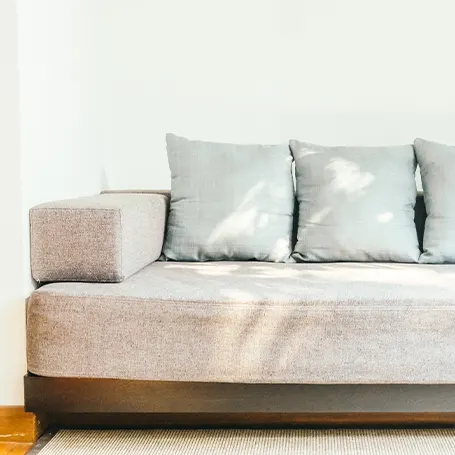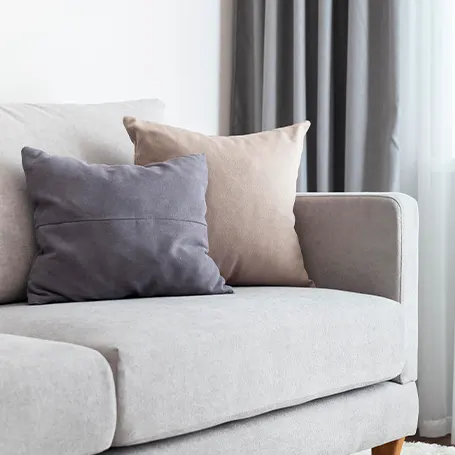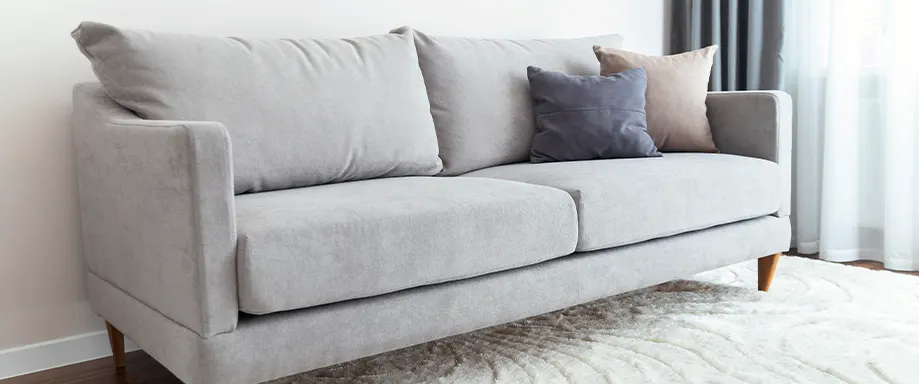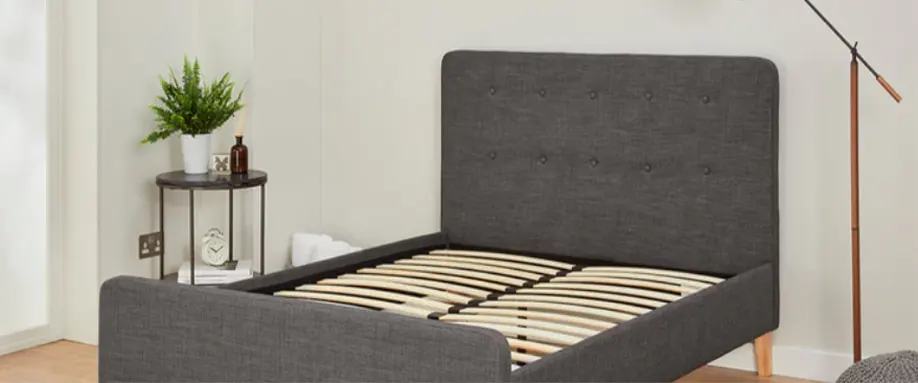Sofa bed mechanism types – which sofa do you have?

To determine how to make your sofa more comfortable, we must first determine which sofa type you have. And that's because, between an easy-open sofa bed and a pull-out sofa bed, different tips will apply.
So, let's go over the three main sofa types, based on the mechanism, and see which one you have! However, do note that other sites might call these sofas different names but don't let that confuse you.
We also won't include traditional sofas, as they by design don't have any mechanism.
Plus, as you'll see later on, everything that applies to the first two types will likely apply to a traditional sofa as well.
Easy open sofa beds
An easy-open sofa bed, also sometimes called a slide-out sofa bed, is a sofa that can be easily converted into a bed. In other words, it typically doesn't have a metal construction or a separate mattress inside.
Instead, the sofa cushions are responsible for keeping you comfortable both during the day and at night. So, having good couch cushions is essential if you want to have a comfortable couch.
Click-clack sofa beds
Click-clack sofas are sofas where you usually lift the bottom part of the sofa until you hear a clicking mechanism. After that, you can set down the backrest and transform the sofa into a bed. Just like with the easy-open sofa bed, the couch cushions serve as your main comfort filling.
Something that's also worth bringing up for both these sofa types is that there will also typically be a wedge in the middle of the sofa. We'll get to why this important design feature is relevant a bit later on.
Pull-out sofas
Lastly, we have pull-out sofas. Unlike the previous two types, a pull-out sofa will typically have a dedicated mattress that can be pulled out. This means that whether you have good foam cushions or not doesn't affect your comfort level at night.
This means, that while a pull-out sofa is typically going to be more comfortable than the previous types, it's also the most difficult to remedy. However, there are still a few things you can do.
How to make a sofa bed more comfortable

Okay, now that we know the terminology, let's discuss our actual battle plan. Our main task will be to make the sofa more comfortable overall.
In turn, this should make sleeping on the sofa at night a lot more comfortable as well – at least, in most cases.
We're going to start off with a few tips that you can easily implement and then go into more difficult tips later on.
And if you have any tips of your own, feel free to share in the comments!
But let's first go over the tips we've prepared.
Add padding to the cushions
The easiest way to make any sofa more comfortable is by adding something soft and comfortable on top. This is under the assumption that what's making your couch uncomfortable are old and hard seat cushions.
So, you can add softer throw pillows to amp up the back support. Or, for sleeping, one or more throw blankets on the bottom can make the entire sofa more comfortable. Even something as small as changing out the cushion covers for a slightly thicker, softer model can make a difference.
With that being said, don't expect this to make it feel like a new sofa. This is just a bandage that can make your not-so-new couch feel a bit more comfortable.
Get new pillows
While new pillows can't make your sofa more comfortable, they can help you get more comfortable! For example, if your mattress is too firm and you're a side sleeper, a wedge pillow for your mid-section can keep you comfy.
And if you have neck or back pain, it might not even be the sofa's fault! Sometimes, getting a pillow for neck pain can solve the issue by itself. This is especially true if you're a stomach sleeper, as this sleeping position is the most vulnerable to neck pain.
And during the day, throw pillows can add to the design of the sofa in general! Plus, if there's enough room, you can use throw pillows as back cushions and further make it feel like you're sitting on a new couch.
Get new cushions
If padding alone isn't going to cut it, new cushions might be just what the doctor ordered! However, don't just blindly buy the first foam cushions you find, as you don't want to make an already uncomfortable couch even more uncomfortable! So, keep these short tips in mind.
Do you want a foam cushion?
Foam cushions are rather common when it comes to sofas. This is because cushion foam can adapt to your body and generally give decent support. If it's memory foam, it will make the sofa feel a bit softer and if it's high-density foam, the sofa will be a bit more firm.
However, you don't have to replace your old foam cushions with new foam ones! Microfibre cushions also provide adequate support and are a bit firmer, which can make the couch more comfortable for some people.
Getting the correct size
The only thing worse than an old couch is a lumpy couch. So, make sure to properly measure your current cushions and make sure that both the front and back cushions can be adequately replaced. You'd also typically want to keep the seat depth and height the same, especially if the sofa has any sort of opening mechanism or bent springs.
Keep up the design
While this is a matter of taste, having your throw blanket be one colour, your cushion covers a different colour, and the throw pillows a third can be a bit jarring. So, if you want your new cushions to offer extra support to both your back and your eyes, consider how the new cushions will fit in with the rest of the sofa.
Get a mattress topper
One of the best ways to make an old sofa feel brand-new is to get a good mattress topper! That's because, regardless of the sofa type, a topper can cover up a lot of discomfort. For one, as a topper will typically be thicker than most throw blankets, it can make the sleeping surface a lot softer.
Plus, since toppers were made to enhance sleep, they'll often provide extra support for your entire body. And if the foam cushion is causing you to sweat at night, a cooling topper could even help in terms of temperature regulation.
Lastly, when it comes to click-clack or easy-open sofa beds, the topper won't even take up more room. You can just leave it on the sofa during the day to make even sitting more comfortable. However, a pull-out sofa would require you to stash the topper elsewhere.
When do you need a new sofa?

If all else fails, you might just need a new couch. After all, no amount of pillows can make as much of a difference as new furniture. However, do you really need a new sofa? Well, here are the main warning signs we'd suggest looking out for.
- The sofa is older than 5 years – While sofas can theoretically last for much longer, anything over 5 years is bound to succumb to wear and tear.
- The cushions are damaged – If the cushions are lumpy, the once hard edge has gone soft, and/or the cushion cover is ripper, it might be time to find a new place to sit.
- The frame is damaged – If the opening mechanism seems faulty or the pull-out mattress doesn't have a secure fit anymore, you might need a new couch.
How to buy a good new sofa?

Like with everything in life, the best way to make a good decision is to learn from past mistakes. Therefore, if you decide that you need a new couch, examine how your current couch has performed.
For example, if your current couch used memory foam cushions and you had lower back pain as a stomach sleeper, you need a firmer model.
So, try to find a couch that uses high-density foam or microfibre!
You can also change to a different opening mechanism if you, for example, have found that a pull-out couch is too difficult to set up.
And, of course, to ensure you buy quality stuff, check whether The Sleep Advisors have a review of the new sofa you've found!
My new sofa is uncomfortable – what can I do?
So far we've mostly focused on old sofas that have moved past their prime. But what if your new sofa is the problem? Well, here are a few tips that will hopefully help you salvage the situation.
Give it some time
If the sofa has just entered your living room one hour ago, you should give it a bit more time. This is especially true if the couch has foam cushions – which a lot of them do. Foam takes a night or two to fully expand, so, it will always feel a bit uncomfortable out of the box.
Even foam mattresses need a bit of time to get comfortable! So, check whether it's a foam cushion and, if so, give it at least one night before you start panicking.
Compare it to your previous sofa
Expectations can be tricky. And, your new couch might feel like it's made of rocks when in reality your old couch was simply too soft. Or, the new upholstery can feel weird to the touch because the old one came with a slipcover.
Whatever the reason might be, it's important to keep in mind that a different filling or fabric will take a bit of time to get used to. This doesn't mean that you should just accept discomfort but rather that you should try to stay level-headed and see what's an actual drawback and what's just a slight change.
Contact customer support
Couches are expensive. So, if you've been sleeping on your new couch for a few nights and it still feels uncomfortable, it might be time to try and get a refund. Sure, you could try to soften it up with our previous tips but that shouldn't be your go-to solution. After all, you shouldn't have to settle for a new sofa you've just bought!
How to open a sofa bed
It depends on the sofa opening mechanism type. There can also be differences based on the specific make of the sofa. So, it's always best to check the user manual. But as a general rule of thumb, this is how you'd typically open a sofa bed.
- Click-clack sofas: Lift the bottom half towards the backrest until you hear a click. Then simply lower the bottom half back down.
- Easy-open sofas: Slightly lift the bottom half of the sofa and pull it towards yourself. There should be enough space for the backrest to fit. Then simply push the backrest down into the created hole.
- Pull-out sofas: Remote all cushions from the sofa. From the lower half of the sofa, pull out the mattress that is inside. Make sure that the legs of the sofa bed are firmly on the ground.
Conclusion
And that's all you need to know on how to make a sofa more comfortable! If you have any tips of your own, feel free to share them in the comments.
Spread the word
Recommended reading:

















There are no comments yet
"*" indicates required fields